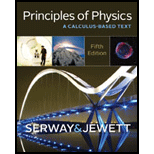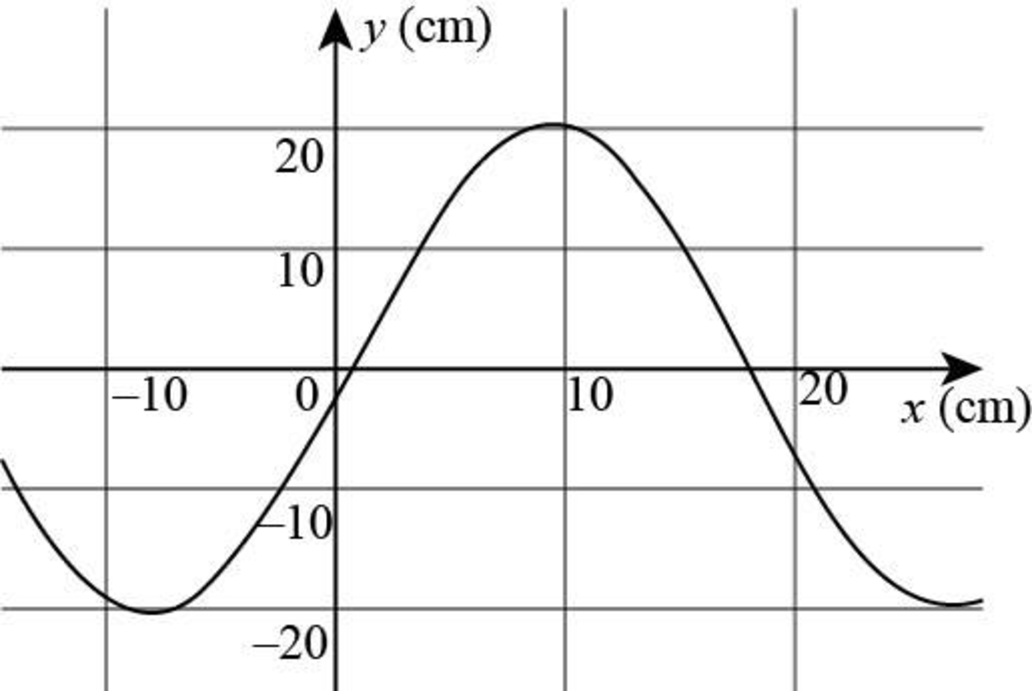
Concept explainers
(a)
The sinusoidal wave at time
(a)
Answer to Problem 12P
The sinusoidal wave at time
 .
.
Explanation of Solution
The wave is traveling in the negative
The general expression for the wave function of a sinusoidal wave is,
Here,
Substitute
At
Substitute
At
The graph for the above equation (III) is shown below.

Figure I
Conclusion:
Therefore, the sinusoidal wave at time
(b)
The angular wave number.
(b)
Answer to Problem 12P
The angular wave number is
Explanation of Solution
Formula to calculate the angular wave number is,
Substitute
Conclusion:
Therefore, the angular wave number is
(c)
The period of the wave from frequency.
(c)
Answer to Problem 12P
The period of the wave from frequency is
Explanation of Solution
Formula to calculate the period is,
Substitute
Conclusion:
Therefore, the period of the wave from frequency is
(d)
The angular frequency of the wave.
(d)
Answer to Problem 12P
The angular frequency of the wave is
Explanation of Solution
Formula to calculate the angular frequency is,
Substitute
Conclusion:
Therefore, the angular frequency of the wave is
(e)
The speed of the wave.
(e)
Answer to Problem 12P
The speed of the wave is
Explanation of Solution
Formula to calculate the speed of the wave is,
Substitute
Conclusion:
Therefore, the speed of the wave is
(f)
The phase constant
(f)
Answer to Problem 12P
The phase constant
Explanation of Solution
As calculated in part (a), the phase constant is,
Conclusion:
Therefore, the phase constant
(g)
The expression for the wave function
(g)
Answer to Problem 12P
The expression for the wave function is,
Explanation of Solution
The expression for the wave function from equation (II) is,
Or it may be written as,
Here,
Conclusion:
Therefore, the expression for the wave function
Want to see more full solutions like this?
Chapter 13 Solutions
Principles of Physics
- Two sinusoidal waves are moving through a medium in the same direction, both having amplitudes of 3.00 cm, a wavelength of 5.20 m, and a period of 6.52 s, but one has a phase shift of an angle . What is the phase shift if the resultant wave has an amplitude of 5.00 cm? [Hint: Use the trig identity sinu+sinv=2sin(u+v2)cos(uv2)arrow_forwardA taut rope has a mass of 0.180 kg and a length of 3.60 m. What power must be supplied to the rope so as to generate sinusoidal waves having an amplitude of 0.100 m and a wavelength of 0.500 m and traveling with a speed of 30.0 m/s?arrow_forwardA transverse wave on a string is described by the wave function y=0.120sin(8x+4t) where x and y are in meters and t is in seconds. Determine (a) the transverse speed and (b) the transverse acceleration at t = 0.200 s for an element of the string located at x = 1.60 m. What are (c) the wavelength, (d) the period, and (e) the speed of propagation of this wave?arrow_forward
- By what factor would you have to multiply the tension in a stretched string so as to double the wave speed? Assume the string does not stretch. (a) a factor of 8 (b) a factor of 4 (c) a factor of 2 (d) a factor of 0.5 (e) You could not change the speed by a predictable factor by changing the tension.arrow_forwardThe amplitude of a wave is doubled, with no other changes made to the wave. As a result of this doubling, which of the following statements is correct? (a) The speed of the wave changes. (b) The frequency of the wave changes. (c) The maximum transverse speed of an element of the medium changes. (d) Statements (a) through (c) are all true. (e) None of statements (a) through (c) is true.arrow_forwardA sound wave can be characterized as (a) a transverse wave, (b) a longitudinal wave, (c) a transverse wave or a longitudinal wave, depending on the nature of its source, (d) one that carries no energy, or (e) a wave that does not require a medium to be transmitted from one place to the other.arrow_forward
- A source vibrating at constant frequency generates a sinusoidal wave on a string under constant tension. If the power delivered to the string is doubled, by what factor does the amplitude change? (a) a factor of 4 (b) a factor of 2 (c) a factor of 2 (d) a factor of 0.707 (e) cannot be predictedarrow_forwardA sound wave in air has a pressure amplitude equal to 4.00 103 Pa. Calculate the displacement amplitude of the wave at a frequency of 10.0 kHz.arrow_forwardA steel wire of length 30.0 m and a copper wire of length 20.0 m, both with 1.00-mm diameters, are connected end to end and stretched to a tension of 150 N. During what time interval will a transverse wave travel the entire length of the two wires?arrow_forward
 Physics for Scientists and Engineers, Technology ...PhysicsISBN:9781305116399Author:Raymond A. Serway, John W. JewettPublisher:Cengage Learning
Physics for Scientists and Engineers, Technology ...PhysicsISBN:9781305116399Author:Raymond A. Serway, John W. JewettPublisher:Cengage Learning Physics for Scientists and Engineers: Foundations...PhysicsISBN:9781133939146Author:Katz, Debora M.Publisher:Cengage Learning
Physics for Scientists and Engineers: Foundations...PhysicsISBN:9781133939146Author:Katz, Debora M.Publisher:Cengage Learning Principles of Physics: A Calculus-Based TextPhysicsISBN:9781133104261Author:Raymond A. Serway, John W. JewettPublisher:Cengage Learning
Principles of Physics: A Calculus-Based TextPhysicsISBN:9781133104261Author:Raymond A. Serway, John W. JewettPublisher:Cengage Learning University Physics Volume 1PhysicsISBN:9781938168277Author:William Moebs, Samuel J. Ling, Jeff SannyPublisher:OpenStax - Rice University
University Physics Volume 1PhysicsISBN:9781938168277Author:William Moebs, Samuel J. Ling, Jeff SannyPublisher:OpenStax - Rice University



